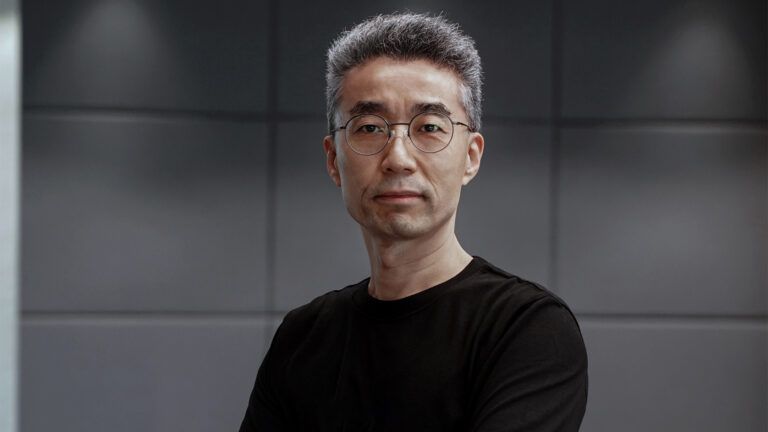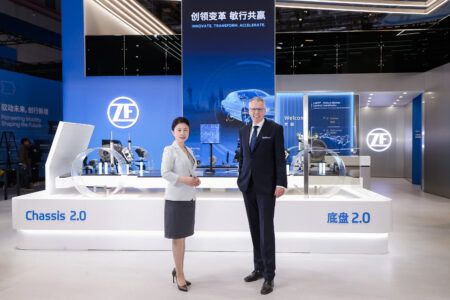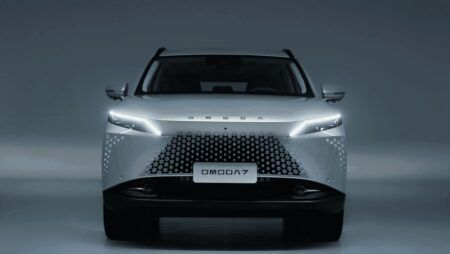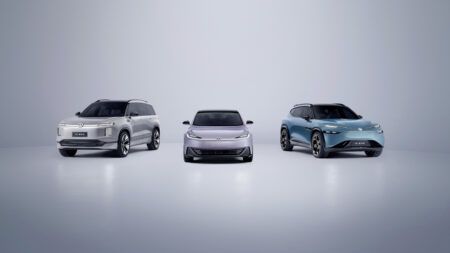President Chang-Hyeon Song, head of the new Transportation-as-a-Service Division at Hyundai Motor Group, discusses the importance of software defined mobility in shaping a future beyond vehicles.
It is very easy to get swept up in the unashamed future-gazing that goes on at the Consumer Electronics Show in Las Vegas. The tech and software symposium that takes place every year under the shimmering lights of Sin City is an excuse for brands to showcase a vision of what lies ahead when everything from AI to robotics, software to hardware become ever-more entwined in our daily lives.
OEMs have traditionally used the event as a stage to showcase future infotainment systems, breakthroughs in autonomous driving technology and early looks at alternative powertrains, and much of it has been as pie-in-the-sky as the wearable oven that drew crowds this year.
But for Chang-Hyeon Song, a recently appointed President and Head of Hyundai Motor Group’s new Transportation-as-a-Service (TaaS) Division, CES feels like home. A former employee of Apple and Microsoft, he is also the founder of Naver Labs, a company Song himself refers to as ‘the Google of Korea’. Software is his language, and his focus is to realise Hyundai’s Software-defined Everything (SDx) strategy that will transform the business from a maker of cars and commercial vehicles into a smart mobility solutions provider.
“Our vision goes beyond vehicles,” Song explains. “It’s about empowering a mobility ecosystem. We see movement as a new source of knowledge and innovation. And our solutions and devices make that knowledge universally useful.”
Prior to taking his role at the Hyundai Motor Group, Song also founded autonomous transportation-as-a-service start-up 42dot back in 2019, a company that Hyundai Motor Group (HMG) acquired three years later for 427.6 billion won (around £255 million or $330 million).
His work at 42dot, as well as his experience at tech giants like Apple and Microsoft, ensure Song is perfectly placed to spearhead a project that will ultimately result in the entire mobility ecosystem that Hyundai Motor Group envisions. This could include autonomous electric cars, ride-hailing services and electrified commercial vehicles, harnessing the power of software and AI to make it safe and convenient for the end user to seamlessly move around the urban environment.
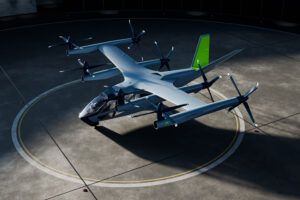
Small steps
Although the overarching picture will one day be a seamless interconnected web of Hyundai-branded mobility solutions, Song admits that there is a long way to go before it becomes a reality.
“The company is moving towards a software-defined vehicle future, to enable faster updates and continuous improvement to our products,” he says. “So, the focus for me over the next two years is to introduce a new infotainment platform, which we are calling SDV OS, which will include an integrated AI assistant and offer an app marketplace to customers.
“I’m a big Apple fan and have always loved CarPlay. I’m also a big believer that a good infotainment system and in-car user experience should be as easy as using and updating your smartphone. That’s what we should strive for.”
This strategy will manifest itself in an overhaul of Hyundai and Kia infotainment systems over the coming years, offering customers the ability to download apps and purchase services from an online marketplace, such as User Based Insurance, which harnesses data from the vehicle to deliver a more bespoke – and potentially cheaper – insurance product to the end user.
“To do this, we are currently opening our API to third party developers and saying, ‘Here is our data, try and improve on what we have and take advantage of what we have built’ so we can develop a killer app that uses the vehicle data to offer more to the user,” he says. “I think that’s what distinguishes us from many other OEMs, the fact we are being open.”
Although not completely unique – President Song is quick to mention Mercedes-Benz and the work the German automotive giant is undertaking on its own MB.OS platform – HMG’s upcoming operating system will provide the fundamentals for the constantly connected, easily updated next generation of SDV.
Learning the language
Although Artificial Intelligence will play a much greater role in Hyundai Motor Group’s smart mobility masterplan, the first forays into the tech have already been made, as Chang-Hyeon Song brings his learnings from Naver Labs to the automotive world.
“The issue with current Large Learning Models (LLM) is that they don’t have access to vehicle data,” Song said after revealing that his team were already in advanced stages of creating its own Artificial Intelligence-based LLM for use in upcoming Hyundai Motor Group vehicles. “These models don’t have access to phone contacts, they don’t have access to vehicle settings and driver data, meaning current models can’t give users all of the answers.”
Naver Labs already has its own LLM and considering it acts as a search engine, mapping and productivity solutions provider in South Korea, it already has deep experience in harnessing AI to make things easier for the end user.
Song said he wanted to create a ‘hybrid’ voice assistant system that would send generic questions out to things like ChatGPT, Naver and other such digital services for answers, but would also use the likes of Mapbox’s MapGPT’s location-intelligent AI voice assistant when it comes to conversational navigational requests and its own voice assistant for vehicle functionality.
Again, referring to his admiration for CarPlay, Song wants this LLM to work seamlessly across all systems, enabling drivers to use voice commands to control in-vehicle functionality, including climate control, windows and music, as well as integrate popular external apps, such as OpenTable and TripAdvisor into its upcoming navigation system – all of which can be interacted with using conversational, natural language.
This sentiment was previously echoed by Charles Ryu, Senior Vice President and Head of the Global Brand & CX Division at sister company Kia, who revealed during its inaugural EV Day last year that upcoming Kia EV models would feature an advanced AI chatbot that would allow customers to do everything from book in scheduled servicing and maintenance, to securing tables at restaurants.
Song understands that AI is hot property right now, referring to the fact Volkswagen chose CES to announce its partnership with ChatGPT, introducing it to vehicles later this year, while Mercedes-Benz also revealed details of its own AI-powered voice assistant.
But more than just a gimmick that allows customers to ‘talk’ to their cars, Song feels that developing an in-house LLM will be an important foundation for future forms of advanced mobility, whether that’s booking a driverless robo-taxi or adjusting the ambience inside your DICE (Digital Curated Experience) autonomous mobility pod (see Rolling the DICE).

Everything is connected
Although a new infotainment system and an AI-infused voice assistant might sound like simple first steps, the Hyundai Motor Group feels that it is the basis from which to launch its software-defined future.
The automaker feels that as SDVs become more commonplace and standardised, it will make management of large-scale fleets much easier and more efficient. Thinking beyond the private owner, HMG wants to give B2B customers access to real-time data analytics and user-friendly administrative interfaces, allowing them to operate vehicles more efficiently and address real-time issues, without the need for separate telematics devices.
At this year’s CES, Hyundai Motor Group laid out its vision of the future where vehicles, fleets and mobility in general eventually become managed and defined by Artificial Intelligence. Defined as ‘transportation-as-a-service,’ Hyundai believes it will allow users to freely access transportation and mobility services when required.
Everything from devices to city infrastructure will be interconnected within an ecosystem, enabling on-demand access to transportation, while the use of AI will increase the intelligence of the service over time. Hyundai says there will be a time when it will be able to predict when a customer requires a ride from one side of the city to another, negating the need for third party apps.
Song believes his experience with developing autonomous vehicles through his company 42dot has primed him for this bold new vision, while a partnership with Samsung, which will provide its latest premium automotive processor, dubbed Exynos Auto, will deliver the hardware to realise this new software-driven approach.
Although it’s easy to feel that autonomous passenger pods and Hyundai’s belief that obsolete ‘mobility modules’ could become an office space or even a pop–up shop are fanciful sci-fi daydreams, it is clear The Group has a road map that stretches far beyond the passenger car and mobility solutions we know and recognise today.
Further proof of this could be found in the parking lot of the Las Vegas Convention Center, where Hyundai’s electric vertical take-off and landing (eVTOL) sub-brand, Supernal, showcased its S-A2 – an electrified, eight-rotor flying craft that will go into its testing phase next year. We could soon find that Supernal becomes the ‘Uber of the skies’, with software, AI and everything that Song has talked about so far playing an important role in its seamless operation.
The talent to make it work
“I spend at least a third of my time trying to hire the right people,” Song explains when quizzed about the biggest issues facing Hyundai Motor Group’s push towards a software-defined future. “There’s so much competition out there for talented people in tech, and that’s the kind of person I want to attract. We still hire a lot of people from the automotive industry, but their mindset often isn’t right for what we are trying to achieve. But then if I hire from tech companies, those people don’t really understand automotive. So, I have to give them a lot of direction.”
Although the old adage of ‘move fast and break things’ doesn’t quite apply to the approach Song is taking within the Hyundai Motor Group, he admits that there needs to be a big shift in the way the company has to think and act if it is to keep up with the pace of change.
“We approach things with a tech mindset and Hyundai is very traditional, so the company has very different processes,” he says. “I have to be mindful of this, because once 42dot became part of The Group, any mistakes we made also became the mistakes of The Group. It has made us become safer; it has really helped us.”
Although Song says changing the way Hyundai Motor Group approaches software was slow at first, he says things are now changing “very fast”, with the business in general accepting that it has to think like a tech company if it wants to successfully move into this space.
“That’s part of the reason I came to CES0,” he concludes, “Because I wanted to lay out the challenges we face and the problems we need to solve and send a message for the right people to join us.”
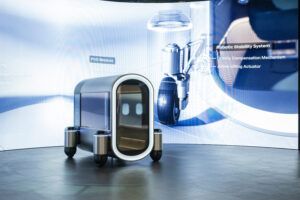
Rolling the DICE
Hyundai’s Digital Curated Experience, which was on display on its substantial stand at this year’s CES, gives an insight into what we could expect from Group’s future mobility solutions.
Dubbed a ‘personal mobility platform’, the highly autonomous pod is more like a small lounge on wheels than it is a car or EV that we might expect to be donning a Hyundai badge. It provides “curated services through software technology”, according to Hyundai, while displays on all walls offer an immersive user experience when travelling.
The user interacts with a ‘kinetic interface’, which is akin to an AI-powered digital face that communicates with the user via natural language, while a bio-sensing camera can pick-up on how the passenger is feeling and adjust the environment accordingly.
Larger versions of DICE, dubbed SPACE (Spatial Curated Experience), can be tailored even more to the user’s tastes and requirements, while obsolete mobility modules can then be transformed into moveable pieces of architecture, be it office space or pop-up shops.


